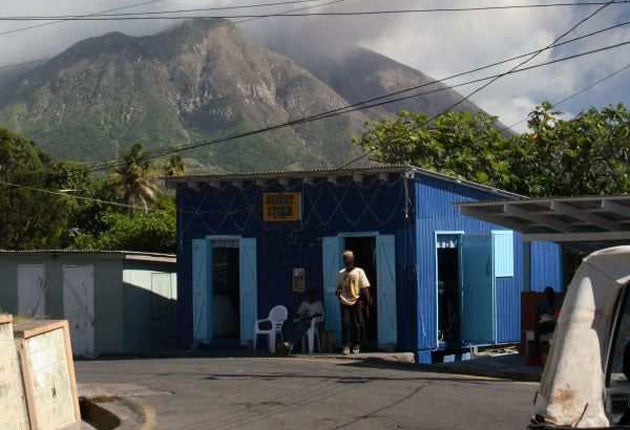Montserrat: this Caribbean island is rising from the ashes.
A new boat service could increase visitor numbers to Montserrat, as it learns to live with its restless volcano, says Kate Simon

Your support helps us to tell the story
From reproductive rights to climate change to Big Tech, The Independent is on the ground when the story is developing. Whether it's investigating the financials of Elon Musk's pro-Trump PAC or producing our latest documentary, 'The A Word', which shines a light on the American women fighting for reproductive rights, we know how important it is to parse out the facts from the messaging.
At such a critical moment in US history, we need reporters on the ground. Your donation allows us to keep sending journalists to speak to both sides of the story.
The Independent is trusted by Americans across the entire political spectrum. And unlike many other quality news outlets, we choose not to lock Americans out of our reporting and analysis with paywalls. We believe quality journalism should be available to everyone, paid for by those who can afford it.
Your support makes all the difference.'Montserrat? An island in the Caribbean? Are you sure?" What an ignorant question and one that was testing the patience of the new man in my life, Dean, who was, yes, sure that he knew where his own parents had been born.
He'd never been to Montserrat, so we decided to go. And we found a lush little island with black-sand beaches and gingerbread houses, some of which were adorned with shamrocks, hinting at this UK overseas territory's Irish links from the time it was enslaved by former Irish indentured labourers – also revealing the root of Dean's family name, Ryan. And we met a community so tight that just the mention of Dean's mother's name placed him as one of the Ryans from Harris' Village.
We explored the neat capital, Plymouth, still guarded by its ancient cannons, and swung by Air Studios to see where Sir George Martin once brought his superstar mates to make music. And we went for a walk in the Soufrière Hills, which spat sulphur with such ferocity that I wondered aloud if they might erupt. Twelve months later, they did.
Fourteen years on, we revisited and found a very different island, now in the fifth phase of ongoing eruption according to the scientists at the Montserrat Volcano Observatory. The most obvious change is the obliteration of the south, including Plymouth, cremated by successive pyroclastic flows and now out of bounds.
But another profound difference is the landscape in which live the remaining 5,000 islanders, half the original inhabitants. The colourful clapboard houses, scattered among the palm thickets, are slowly being superseded by tidy cul-de-sacs of concrete dwellings. This incongruous north European style of living is the future, courtesy of the coffers of the UK government and other funds. Housing conditions may have improved, but the romance has gone.
Montserrat was never a classic fly-and-flop Caribbean getaway, thanks to all that black sand. But the continuing seismic activity presents a greater challenge. While volcano tourism has perversely opened up a profitable niche market, the Montserratians are working hard to provide other inducements for visitors.
One idea is activity holidays. Hiking and birdwatching are established pursuits and continue in the two intact mountain ranges, the Silver and Centre Hills. But Zekie's Horseback Riding Tours, which set up business earlier this year, is one of the newer offerings, including in its programme a trot across the volcanic wastelands of the Belham Valley. And a new diving centre, Scuba Montserrat, is providing excursions to the island's dive sites – which have been enhanced by the rockfalls – while hedging its bets with sidelines such as boat tours guided by locals who will regale their experiences of the eruptions.
Meanwhile, an urban centre is being developed at Little Bay, promising a museum, hotel, shops and a marina. This comes on top of other post-volcano projects, including the Montserrat Cultural Centre, built with funds raised by Sir George, a cricket ground, and a new football pitch paid for by Fifa.
All these efforts would have been hobbled by the inaccessibility of the island but for this month's welcome changes. The opening of a new airport in the north in 2005 spelt the end of the boat from Antigua and meant the only connection could be made on Winair's 25-minute air service. Running just four times a day and using a 19-seater Twin Otter, that capped visitors at 76 a day and allowed little capacity for luggage.
But on 11 December the ferry service resumed, promising up to 107 more passengers at a time on the 80-minute crossing, sailing once a day six days a week in high season. Plus, Winair has added cargo flights to carry more luggage to the island.
The extra arrivals will come as good news to Montserrat's legion of taxi drivers, who for some time have outnumbered passengers at John A Osborne Airport. But despite the Montserratians best efforts, the shape of the future remains at the whim of the mighty volcano.
How to get there
Kate Simon was hosted on the island by the Montserrat Tourist Board (020-7928 1600; www.visitmontserrat.com). Flights with Winair and ferry crossings can be booked on the website. She travelled to the Caribbean courtesy of BA Holidays (0844 493 0758; www.baholidays.com), which is offering seven nights at Carlisle Bay, Antigua, from £2,159 per person, based on two sharing, for departures between 3 and 28 January. Price includes return BA flights to Antigua, free UK connecting flights, B&B and transfers.
Join our commenting forum
Join thought-provoking conversations, follow other Independent readers and see their replies
Comments